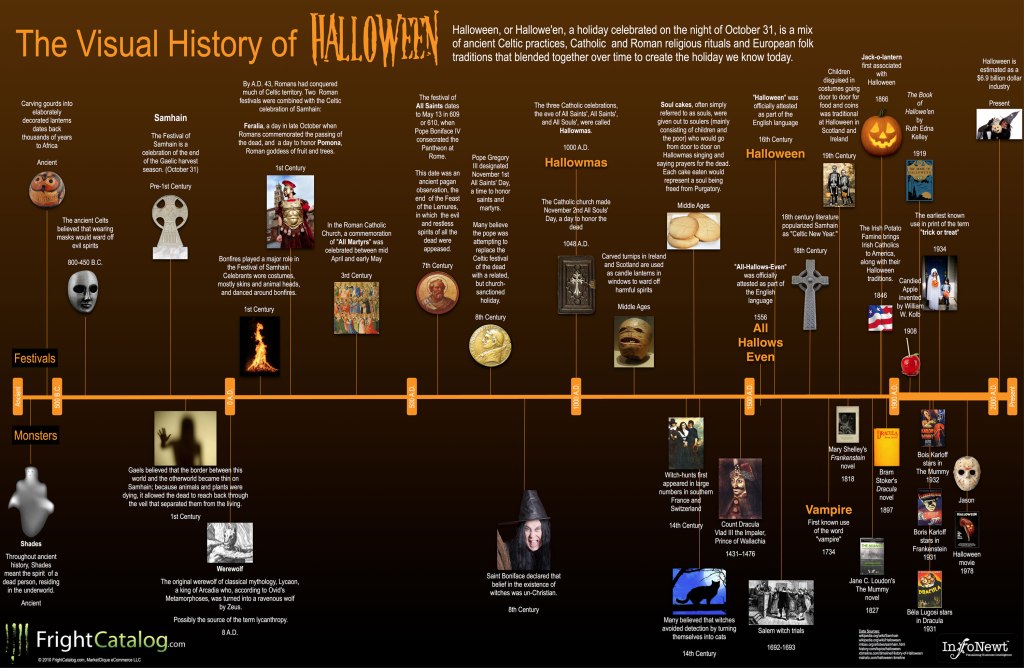By Emma Louise Backe
I think it’s safe to say that anthropologists don’t scare easily. During fieldwork, anthropologists may be called upon to communicate with demons or spirits through a shaman or spiritual conduit; confront death and mourning rituals; interface with corpses or occult artifacts; or negotiate conditions of extreme poverty, violence or illness. Anthropology also requires a certain amount of existential and physical vulnerability from its practitioners throughout ethnographic research; anthropologists may be called upon to enter dangerous, uncomfortable, eerie and perhaps frightening scenarios for the sake of their fieldwork. Many anthropologists, questing after research in the subaltern, dispossessed or invisible aspects of societies or cultures, regularly deal in patterns of fright and death, spooks and the supernatural, and the impact of demons—whether spiritual or institution—on the daily lives of people in their ethnographic communities.

From Ossian Brown’s collection of vintage Halloween pictures Haunted Air. Source: http://www.ln-cc.com/content/ebiz/latenightcatcafe/page/ossian-brown-interview/ha_12.jpg
Halloween is said to be a day when the boundaries between the spiritual and human worlds becomes more permeable; it is a holiday that celebrates and commemorates the interstices between life and death, the prosaic and the preternatural. Although Halloween originates from the pre-Christian Celtic festival Samhain, it has spread throughout the world. Other cultures, however, regularly experience the immediate presence of the dead and commune with the spirits during festivals and ceremonies held throughout the year. Within Western cultures, there are other pre-Christian traditions surrounding the supernatural that remain in practice. Walpurgisnacht (named for Saint Walburga) is held at the end of April in the Harz Mountains of Germany, when, according to local mythology, witches and warlocks are said to gather to revel in their wickedness. Charles Fréger, a photographer, has also documented the traditional costumes still worn throughout Europe that remain as a testimony to the lingering power of the spirits. Articles by publications like The Atlantic have also explored persistent beliefs in ghosts amongst Americans and investment in folk superstitions. Even though Halloween may be the one time of the year Americans feel liberated enough to engage in costumery, Ouija board use and enfrightenment, the beliefs that underlie the holiday are tenacious, if not buried beneath the veneer of “modernism.” It’s also interesting to think about what things scare us as a culture; how are our fears culturally inflected and influenced?

Zombie Sailor Scouts in Japan via http://kotaku.com/japan-is-good-at-halloween-1651638038
For your reading pleasure, below we’ve added a few articles of interest regarding the cultural history of Halloween, with some Halloween inspired ethnographies. Halloween, however, is also a time to consider the problem of cultural appropriation in costumes, so we’ve also added some interesting primers on the delineations between respect, appropriation and appreciation. Trick or treat!
An Anthropological Perspective on Halloween
D’Costa, Krystal (2009). “The Spirit of America—Haunted and Hallowed.” Anthropology in Practice. http://www.anthropologyinpractice.com/2009/10/from-melting-pot-to-salad-halloween.html
Erickson, Ken C. & Patricia Sunderland (1998). “Where Our Weird Habits Originated.” The Washington Post. http://www.washingtonpost.com/wp-srv/national/horizon/oct98/hallo101498.htm
“From Hallowed to Shallow? The Evolution of Halloween as a Consumer Ritual” (2012). The Narcissistic Anthropologist. http://thenarcissisticanthropologist.com/2012/10/31/from-hallowed-to-shallow-the-evolution-of-halloween-as-a-consumer-ritual/
National Geographic (2013). “Halloween 2013: Top Costumes, History, Myths, More.” National Geographic News. http://news.nationalgeographic.com/news/2013/10/101029-halloween-costumes-ideas-history-science-nation/
Santino, Jack (2009). “The Fantasy and Folklore of All Hallows.” The American Folklife Center. http://www.loc.gov/folklife/halloween.html
Cultural Appropriation in Halloween Costumes
Albers, Rachel K. (2014). “Dear Cultural Appropriators: Stop! Love, Halloween.” http://feminspire.com/dear-cultural-appropriators-stop-love-halloween/
Dawisha, Nadia (2014). “Halloween: The Season for Culturally-Insensitive Fashion.” The Huffington Post. http://www.huffingtonpost.com/nadia-dawisha-/culturally-insensitive-fashion_b_6070292.html
Kendall, Mikki (2014). “How To Not Wear a Racist Halloween Costume This Year.” The Bustle. http://www.bustle.com/articles/43322-how-to-not-wear-a-racist-halloween-costume-this-year-a-simple-guide-for-white-people
Lazo, Kat (2013). “Is Your Halloween Costume Racist?” Everyday Feminism. http://everydayfeminism.com/2013/10/is-your-halloween-costume-racist/
Native Appropriations (2014). “Step Away From the ‘Indian’ Costume.” http://nativeappropriations.com/2014/10/10-days-until-halloween-step-away-from-the-indian-costume.html
Rey, PJ (2013). “Cultural Appropriation: Halloween’s Post-Modern Problem.” The Society Pages. http://thesocietypages.org/cyborgology/2013/11/01/cultural-appropriation-halloweens-post-modern-problem/

“We’re A Culture Not a Costume” Campaign via: http://www.ohio.edu/orgs/stars/Poster_Campaign.html
“Halloween” Ethnographies
Brandes, Stanley (2007). Skulls to the Living, Bread to the Dead: The Day of the Dead in Mexico and Beyond. Wiley-Blackwell.
Brunvand, Jan Harold (2004). Be Afraid, Be Very Afraid: The Book of Scary Urban Legends. New York: W.W. Norton & Company.
Evans-Pritchard, E.E. (1976). Witchcraft, Oracles and Magic Among the Azande. Oxford: Oxford University Press.
Favret-Saada, Jeanne & Catherine Cullen (1981). Deadly Words: Witchcraft in the Bocage. Cambridge University Press.
Hoy, William G. (2013). Do Funerals Matter? The Purpose and Practices of Death Rituals in Global Perspectives. Routledge.
Koudounaris, Paul (2011). The Empire of Death: A Cultural History of Ossuaries and Charnel Houses. Thames & Hudson.
Poole, W. Scott (2011). Monsters in America: Our Historical Obsession with the Hideous and the Haunting. Baylor University Press.
Roach, Mary (2004). Stiff: The Curious Lives of Human Cadavers. New York: W.W. Norton & Company.
Roach, Mary (2006). Spook: Science Tackles the Afterlife. New York: W.W. Norton & Company.
Sugg, Richard (2011). Mummies, Cannibals and Vampires: The History of Corpse Medicine from the Renaissance to the Victorians. New York: Routledge.

Source: http://www.quickmeme.com/img/f6/f677ce9ee36c2717a2093612f894b308fc915cdf922fed96d6c6c097d7fed57d.jpg
Works Cited
Ashcraft, Brian (2012). “Why Halloween Became a Thing in Japan.” Kotaku. http://kotaku.com/5954768/why-halloween-became-a-thing-in-japan
Estrin, James (2013). “Where The Wild Things Are.” The New York Times. http://lens.blogs.nytimes.com/2013/03/18/where-the-wild-things-are/?_php=true&_type=blogs&_r=0
Lonely Planet (2013). “Walpurgisnacht: celebrate the arrival of spring with witches and warlocks in Germany.” http://www.lonelyplanet.com/germany/travel-tips-and-articles/52160
Wen, Tiffanie (2014). “Why Do People Believe in Ghosts?” The Atlantic. http://www.theatlantic.com/health/archive/2014/09/why-do-people-believe-in-ghosts/379072/







[…] If you want to read about this history and interpretation of our hallows day celebrations, I recommend this and this. […]
LikeLike
[…] made for anthropologists. At this point, I hope that it is evident to most of our readers that culture is not a costume and careful consideration should always be taken to avoid cultural appropriation when deciding who […]
LikeLike
Thank you for adding my Huff Post piece on Appropriation to this piece! 🙂
LikeLike
Reblogged this on Conversations I Wish I Had and commented:
“Anthropology also requires a certain amount of existential and physical vulnerability from its practitioners throughout ethnographic research”. Oh so it’s not just me… Glad to know 😉
LikeLike
Reblogged this on Anthromistic and commented:
Happy Halloween!
LikeLike
Reblogged this on Fiesta Estrella.
LikeLike